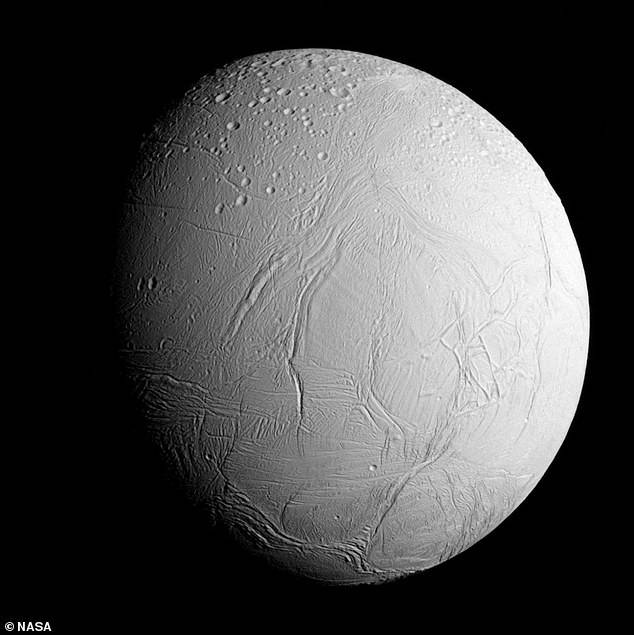NASA's James Webb telescope has detected a 'surprisingly large' plume of water vapour coming from Enceladus's south pole.
Researchers say the plume spans more than 6,000 miles – nearly the distance from Los Angeles to Buenos Aires.
Saturn has more than 100 known moons, but Enceladus is the only one with a liquid water ocean, making it comparable to Earth.
It's unclear what's causing the massive plume, although scientists think the ocean could be home to some sort of extraterrestrial life.
A plume of water escaping from Saturn's moon Enceladus extends 6,000 miles - nearly the distance from Los Angeles to Buenos Aires
Enceladus - Saturn's sixth-largest moon - is a frozen sphere just 313 miles in diameter (about one-seventh the diameter of Earth's moon). The moon is pictured in this image captured by NASA's Cassini spacecraft
Enceladus appears in space as a beautiful sphere of white, covered by a layer of ice layer at least 12 miles thick.
It's already known that jets of water and some solid particles such as ice crystal spout from fractures in the frozen surface called 'tiger stripes'.
But scientists have been left surprised by the size of this particular plume, which marks the first time such a water emission has been seen over such an expansive distance.
'When I was looking at the data, at first, I was thinking I had to be wrong,' said team member Geronimo Villanueva at NASA's Goddard Space Flight Center in Greenbelt, Maryland.
'It was just so shocking to detect a water plume more than 20 times the size of the moon.
'The water plume extends far beyond its release region at the southern pole.'
What's more, water vapour from the plume is gushing out at a rate of about 79 gallons per second, enough to fill an Olympic-sized swimming pool in just a couple of hours.
In comparison, doing so with a garden hose on Earth would take more than two weeks.
NASA’s James Webb Space Telescope revealed a water vapour plume jetting from the southern pole of Enceladus, extending out more than 20 times the size of the moon itself
Enceladus is one of few locations in our solar system with liquid water, along with Earth and Jupiter's moon Europa, making it a target of interest for astrobiologists.
Its global reservoir of salty liquid water is sandwiched between its icy outer crust and rocky core.
Enceladus orbits Saturn at a distance of 148,000 miles, between the orbits of two other moons, Mimas and Tethys.
As it does so, the moon continuously spews out water molecules, leaving behind a torus – or 'donut' – of material in its wake.
'The orbit of Enceladus around Saturn is relatively quick, just 33 hours,' said Villanueva, who is lead author of a study describing the findings, which is available to view as a pre-print.
'As it whips around Saturn, the moon and its jets are basically spitting off water, leaving a halo, almost like a donut, in its wake.
'In the Webb observations, not only was the plume huge, but there was just water absolutely everywhere.'
What's more, the moon is feeding a water supply to the entire Saturnian system, including the planet itself and its other moons.
By analysing Webb's data, the team found roughly 30 per cent of the water stays within this torus, while the other 70 per cent escapes to supply the rest of the system.
Cutaway illustration of the interior of Saturn's moon Enceladus showing a global liquid water ocean between its rocky core and icy crust. Thickness of layers shown here is not to scale
At this point it's still uncertain whether or not the moon's liquid ocean is home to life, although researchers have said the moon 'meets the criteria' for doing so.
Experts revealed last December that the ocean contains phosphorus, a vital building block of life that's used to construct DNA and RNA.
'We knew that Enceladus had most of the elements that are essential for life as we know it – carbon, hydrogen, nitrogen, oxygen and sulfur,' Morgan Cable, an astrobiologist at the Jet Propulsion Laboratory in Pasadena, told Science News.
'Now that [phosphorus] has been confirmed … Enceladus now appears to meet all of the criteria for a habitable ocean.'
Researchers also know that the moon's ocean spews out methane gas – an organic molecule typically produced or used by microbial life.
The presence of methane in these plumes has led scientists to hypothesise that microbes may be living, or have lived, underneath Enceladus' shell.
Enceladus was first surveyed by NASA's Voyager 1 in 1980, which allowed scientists to marvel its reflective icy shell, but was otherwise not seen as very exciting.
Cassini is depicted here in a NASA illustration. Cassini launched from Cape Canaveral, Florida in October 1997
However, the moon attracted greater attention in 2014 thanks to data from the now retired Cassini space probe.
At the time, the plucky spacecraft discovered evidence of its large subsurface ocean and sampled water from geyser-like eruptions that occur through fissures in the ice at its south pole.
Cassini spent over a decade exploring Saturn and its known moons, and not only imaged the plumes of Enceladus for the first time but flew directly through them.


